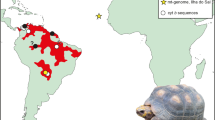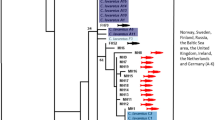Abstract
Ancient DNA data have supported a sister relationship between woolly rhinoceros and extant Sumatran rhinoceros. This relationship has been used to explore the divergent times for the woolly rhinoceros from their relatives. Complete and partial ancient DNA sequences of the mitochondrial cytochrome b (cyt b) gene were retrieved from bones of the late Pleistocene Coelodonta antiquitatis excavated from northern and northeastern China. The newly obtained sequences together with the European and northern Asian Coelodonta antiquitatis sequences from GenBank were used to estimate the evolutionary divergence time. Phylogenetic analyses showed the exchange of genetic information between the Chinese individuals and Coelodonta antiquitatis of north Asia, which also indicated a more recent evolutionary timescale (3.8–4.7 Ma) than previous molecular estimations (17.5–22.8 or 21–26 Ma) for woolly rhinoceros based on the fossil calibration of outgroups. This new timescale was more consistent with the fossil record of the earliest known genus Coelodonta.
Similar content being viewed by others
References
Álvarez-Lao D, García-García N. 2006. A new site from the Spanish middle Pleistocene with cold-resistant faunal elements: La Parte (Asturias, Spain). Quatern Int, 142–143: 107–118
Arnason U, Gullberg A. 1996. Cytochrome b nucleotide sequences and the identification of five primary lineages of extant cetaceans. Mol Biol Evol, 13: 407–417
Bandelt H J, Forster P, Rohl A. 1999. Median joining networks for inferring intraspecific phylogenies. Mol Biol Evol, 16: 37–48
Binladen J, Wiuf C, Gilbert M T P, et al. 2006. Assessing the fidelity of ancient DNA sequences amplified from nuclear genes. Genetics, 172: 733–741
Birungi J, Arctander P. 2001. Molecular systematics and phylogeny of the reduncini (Artiodactyla: Bovidae) inferred from the analysis of mitochondrial cytochrome b gene sequences. J Mamm Evol, 8: 125–147
Brown W M, George J R, Wilson A C. 1979. Rapid evolution of animal mitochondrial DNA. Proc Natl Acad Sci USA, 76: 1967–1971
Burridge C P, Craw D, Fletcher D, et al. 2008. Geological dates and molecular rates: fish DNA sheds light on time dependency. Mol Biol Evol, 25: 624–633
Cai B Q, Yin J C. 1992. Late Pleistocene fossil mammals from Qinggang, Heilongjiang Province (in Chinese with English abstract). Bull Chin Acad Geol Sci, 25: 131–138
Debruyne R, Barriel V, Tassy P. 2003. Mitochondrial cytochrome b of the Lyakhov mammoth (Proboscidea, Mammalia): New data and phylogenetic analyses of Elephantidae. Mol Phylogenet Evol, 26, 421–434
Deng T. 2002. The earliest known woolly rhino discovered in the Linxia Basin, Gansu Province, China (in Chinese with English abstract). Geol Bull Chin, 21: 604–608
Deng T. 2006. Neogene rhinoceroses of the Linxia Basin (Gansu, China). Courier Forschungsinstitut Senckenberg, 256: 43–56
Deng T. 2008. Comparison between woolly rhino forelimbs from Longdan, northwestern China and Tologi, Transbaikalian region. Quatern Int, 179: 196–207
Deng T, Wang X M, Fortelius M, et al. 2011. Out of Tibet: Pliocene woolly rhino suggests high-plateau origin of Ice Age megaherbivores. Science, 333: 1285–1288
Drummond A J, Rammbaut A. 2007. BAEST: Bayesian evolutionary analysis by sampling trees. BMC Evol Biol, 7: 214
Elias S A, Crocker B. 2008. The Bering Land Bridge: a moisture barrier to the dispersal of steppe-tundra biota. Quatern Sci Rev, 27: 2473–2483
Enk J M, Yesner D R, Crossen K J, et al. 2009. Phylogeographic analysis of the mid-Holocene mammoth from Qagnax Cave, St. Paul Island, Alaska. Palaeogeogr Palaeoclimat Palaeoecol, 273: 184–190
Geng R Q, Wang L P, Ji D J, et al. 2011. Phylogenetic relationships among domestic Chinese Bovinae species based on mitochondrial cytochrome b gene sequences (in Chinese with English abstract). Sci Agr Sin, 44: 4081–4087
Gilbert M T P, Drautz D I, Lesk A M, et al. 2008. Intraspecific phylogenetic analysis of Siberian woolly mammoths using complete mitochondrial genomes. Proc Natl Acad Sci USA, 105: 8327–8332
Hofreiter M, Jannicke V, Serre D, et al. 2001. DNA sequences from multiple amplifications reveal artifacts induced by cytosine deamination in ancient DNA. Nucleic Acids Res, 29: 4793–4799
Ho S Y W, Phillips M J, Cooper A, et al. 2005. Time dependency of molecular rate estimates and systematic overestimation of recent divergence times. Mol Biol Evol, 22: 1561–1568
Ho S Y W, Lanfear R, Bromham L, et al. 2011. Time-dependent rates of molecular evolution. Mol Ecol, 20: 3087–3101
Huang W B. 1979. Discovery of woolly rhinoceros fossils in Fuchengmen, Beijing and the late Pleistocene climate (in Chinese). Vertebr Palasiat, 2: 172–175
Irwin D M, Kocher T D, Wilson A C. 1991. Evolution of the cytochrome b gene of mammals. J Mol Evol, 32: 128–144
Jiang P. 1982. Preliminary probe on Mammuthus-Coelodonta fauna of northeastern China (in Chinese with English abstract). J Northeast Normal Univ (Nat Sci Ed), 1: 105–115
Jiang P. 1991. Discovery of a comparatively complete skeleton of Coelodonta in Fuyu, Jilin (in Chinese with English abstract). Acta Anthropol Sin, 10: 78–82
Jin C Z, Xu Q Q, Li C T. 1984. The Quaternary mammalian faunas from Qingshantou Site, Jilin Province (in Chinese with English abstract). Vertebr Palasiat, 4: 314–323
Kahlke R D, Lacombat F. 2008. The earliest immigration of woolly rhinoceros (Coelodonta tologoijensis, Rhinocerotidae, Mammalia) into Europe and its adaptive evolution in Palaearctic cold stage mammal faunas. Quatern Sci Rev, 27: 1951–1961
Krause J, Dear P H, Pollack J L, et al. 2006. Multiplex amplification of the mammoth mitochondrial genome and the evolution of Elephantidae. Nature, 439: 724–727
Lai X L, Qi S H. 2005. DNA preservation of late Pleistocene materials from China. Abstract of 15th Goldschimidt Conference. Geochem Cosmochem Acta, 69(Suppl): A347–A347
Li Z Y, Dong W. 2007. Mammalian fauna from the Lingjing Paleolithic site in Xuchang, Henan Province (in Chinese with English abstract). Acta Anthropol Sin, 26: 345–360
Lister A M, Sher A V. 2001. The origin and evolution of the woolly mammoth. Science, 294: 1094–1097
Lorenzen E D, Nogués-Bravo D, Orlando L, et al. 2011. Quaternary megafauna to climate and humans. Nature, 479: 359–364
Lu Y Q, Li Y, Jin C Z. 1986. Mammalian remains from the late Pleistocene of Wurji, Nei Mongol (in Chinese with English abstract). Vertebr Palasiat, 2: 152–162
Luo B, Wang Y Z, Huang Q P, et al. 1983. The discovery of the Picea and Coelodonta antiquitalis symbionsis in Tianjin and its significances (in Chinese with English abstract). Sci Geol Sin, 2: 160–164
Ma G Q, Gao T, Sun D R. 2010. Discussion of relationship between Collichthys lucidus and C. Niveatus based on 16S rRNA and cyt b gene sequences (in Chinese with English abstract). South Chin Fisheries Sci, 6: 13–20
Miller W, Drautz D I, Ratan A, et al. 2008. Sequencing the nuclear genome of the extinct woolly mammoth. Nature, 456: 387–390
Nie Z S, Li H, Ma B Q. 2008. Fossil fauna in the late stage of late Pleistocene in the Hetao Basin, Inner Mongolia (in Chinese with English abstract). Quatern Sci, 28: 14–25
Noro M, Masuda R, Dubrovo I A, et al. 1998. Molecular phylogenetic inference of the woolly mammoth Mammuthus primigenius, based on complete sequences of mitochondrial cytochrome b and 12S ribosomal RNA genes. J Mol Evol, 46: 314–326
Orlando L, Leonard J A, Thenot A L, et al. 2003. Ancient DNA analysis reveals woolly rhino evolutionary relationships. Mol Phylogenet Evol, 28: 485–499
Pääbo S, Poinar H, Serre D, et al. 2004. Genetic analyses from ancient DNA. Annual Rev Gen, 38: 645–679
Pei S W. 2001. Discovery of Coelondonta antiquitatis from Hutouliang in Nihewan Basin (in Chinese with English abstract). Vert PalAsiat, 1: 72–75
Rogaev E I, Moliaka Y K, Malyarchuk B A, et al. 2006. Complete mitochondrial genome and phylogeny of Pleistocene mammoth Mammuthus primigenius. PLoS Biol, 4: 403–410
Rohland N, Hofreiter M. 2007a. Comparison and optimization of ancient DNA extraction. BioTechniques, 42: 343–352
Rohland N, Hofreiter M. 2007b. Ancient DNA extraction from bones and teeth. Nat Protoc, 2: 1756–1762
Scott K. 2007. The ecology of the late middle Pleistocene mammoths in Britain. Quatern Int, 169-170: 125–136
Subramanian S, Denver D R, Millar C D, et al. 2009. High mitogenomic evolutionary rates and time dependency. Trends Gen, 25: 482–486
Sun J Z, Wang Y Z. 1983. The strata of northeast China during Dali glaciations (in Chinese). J Strati, 7: 1–11
Tamura K, Dudley J, Nei M, et al. 2007. MEGA 4: molecular evolutionary genetics analysis (MEGA) software version 4.0. Mol Biol Evol, 24: 1596–1599
Tong H W, Claude G. 2009. Early Pleistocene Dicerorhinus sumatrensis remains from the Liucheng Gigantopithecus Cave, Guangxi, China. Geobios, 42: 525–539
Tougard C, Delefosse T, Hänni C M C. 2001. Phylogenetic relationships of the five extant Rhinoceros species (Rhinocerotidae, Perissodactyla) based on mitochondrial cytochrome b and 12S rRNA genes. Mol Phyl Evol, 19: 34–44
Triant D A, DeWoody J A. 2006. Accelerated molecular evolution in Microtus (Rodentia) as assessed via complete mitochondrial genome sequences. Genetica, 128: 95–108
Wei Z Y, Zhu G W. 1990. Coelodonta antiquitatis excavated from Zhaodong (in Chinese). Chin Nat, 2: 27–28
Willerslev E, Gilbert M T P, Binladen J, et al. 2009. Analysis of complete mitochondrial genomes from extinct and extant rhinoceroses reveals lack of phylogenetic resolution. BMC Evol Biol, doi: 10.1186/1471-2148-9-95
Xu G Y. 1986. Dali glacial period in Liaoning Province (in Chinese with English abstract). Liaoning Geol, 1: 60–68
Xu X, Janke A, Arnason U. 1996. The complete mitochondrial DNA sequence of the greater Indian rhinoceros, Rhinoceros unicornis, and the phylogenetic relationship among Carnivora, Perissodactyla, and Artiodactyla (+ Cetacea). Mol Biol Evol, 13: 1167–1173
Xu X, Arnason U. 1997. The complete mitochondrial DNA sequence of the white rhinoceros, Ceratotherium simum, and comparison with the mt DNA sequence of the Indian rhinoceros, Rhinoceros unicornis. Mol Phyl Evol, 7: 189–194
Yang D, Watt K. Contamination controls when preparing archaeological remains for ancient DNA analysis. J Archaeol Sci, 2005, 32: 331–336
Yang H, Golenberg E M, Shoshani J. 1996. Phylogenetic resolution within Elephantidae using fossil DNA sequence from American mastodon (Mammut americanum) as an outgroup. Proc Natl Acad Sci USA, 93: 1190–1194
Yang S J, Lai X L, Shi S H, et al. 2006. New ancient DNA sequences suggest high genetic diversity for the woolly mammoth (Mammuthus primigenius). Prog Nat Sci, 16: 379–386
Zheng J J, Xu Q Q, Jin C Z. 1992. Division of the late Pleistocene mammalian fauna in north China and its geographic distribution (in Chinese with English abstract). J Stratigr, 16: 171–190
Zhou B X. 1978. The distribution of the woolly rhinoceros and woolly mammoth (in Chinese with English abstract). Vertebr Palasiat, 16: 47–59
Zhou M Z. 1964. The Chinese fauna evolution in Quaternary (in Chinese). J Strati, 6: 274–278
Zin M M T, Masanaru T, Takehisa T, et al. 2008. A new species of Dicerorhinus (Rhinocerotidae) from the Plio-Pleistocene of Myanmar. Palaeontol, 51: 1419–1433
Author information
Authors and Affiliations
Corresponding author
Rights and permissions
About this article
Cite this article
Yuan, J., Sheng, G., Hou, X. et al. Ancient DNA sequences from Coelodonta antiquitatis in China reveal its divergence and phylogeny. Sci. China Earth Sci. 57, 388–396 (2014). https://doi.org/10.1007/s11430-013-4702-6
Received:
Accepted:
Published:
Issue Date:
DOI: https://doi.org/10.1007/s11430-013-4702-6




